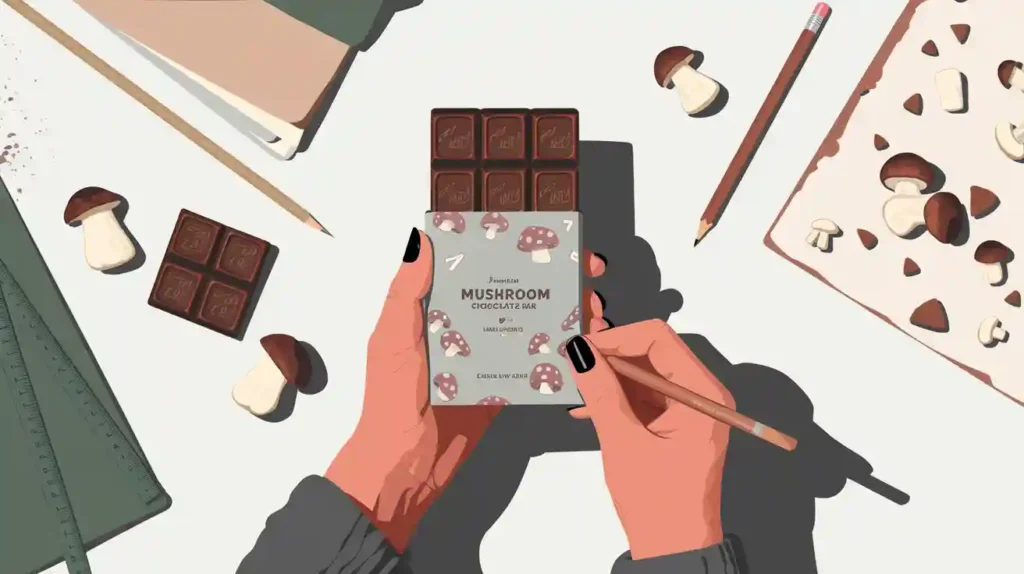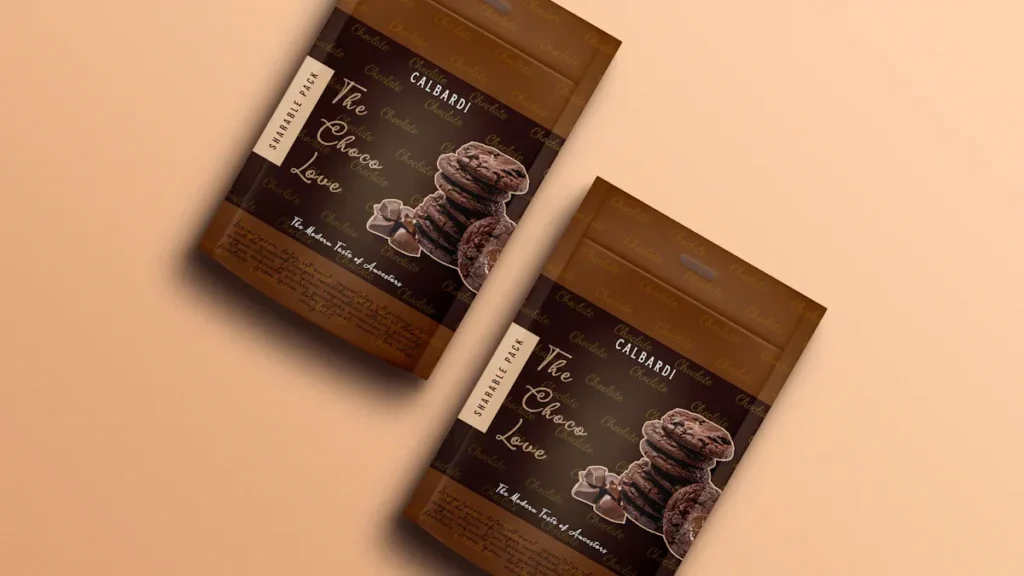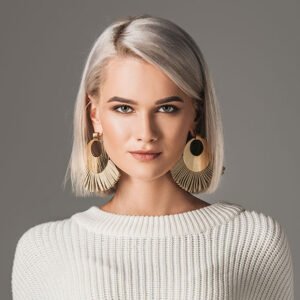
When creating Mushroom Chocolate Bar Packaging, brands begin by analyzing market trends and choosing materials that ensure the chocolate bar packaging keeps the product safe and fresh. The significance of chocolate packaging is clear, with 72% of consumers stating that chocolate bar packaging design influences their purchasing decisions. Innovative and eco-friendly custom chocolate bar packaging, including specialized mushroom chocolate bar packaging and chocolate boxes packaging, allows companies to strengthen their branding, comply with regulations, and draw in loyal customers.
Key Takeaways
Custom mushroom chocolate bar packaging boosts brand appeal by using unique designs, eco-friendly materials, and interactive features that attract and engage customers.
Choosing the right materials like kraft paper, aluminum foil, or mycelium protects the chocolate’s freshness and supports sustainability, helping brands stand out and meet consumer expectations.
Meeting legal and safety standards with clear labeling and child-safe features builds trust and ensures compliance, which strengthens brand reputation and customer loyalty.
Why Packaging Matters
Brand Appeal
Packaging serves as the first point of contact between mushroom chocolate bars and consumers. It acts as a silent salesperson, visually communicating brand quality and identity. Custom chocolate boxes with unique designs, bold colors, and prominent logos help brands stand out on crowded shelves. Packaging innovations, such as QR codes and augmented reality, create interactive experiences that deepen consumer engagement. Emotional appeal through packaging enhances the gift-giving experience and builds loyalty. Customization and branding allow companies to connect directly with their target audience, turning each product into a memorable experience. Eco-friendly packaging options and sustainable materials also reflect brand values, strengthening consumer trust and differentiation.
Product Protection
The importance of packaging extends beyond appearance. Mushroom chocolate bar packaging must protect products from damage during shipping and storage. Chocolate bars are sensitive to temperature, humidity, and light. Using the right material, such as aluminum foil or rigid cardboard, helps maintain freshness and prevent melting or blooming. Packaging with cushioning materials, like foam inserts, absorbs shocks and vibrations. Multi-layer packaging, including airtight bags and sturdy outer boxes, shields chocolate from environmental factors. E-commerce packaging often requires extra protection to ensure products arrive in perfect condition. These strategies support customer satisfaction and repeat business.
Compliance
Compliance is essential for mushroom chocolate bar packaging in both the United States and Europe. Packaging must meet food safety standards and use materials that do not alter the chocolate’s taste or safety. Labels must include ingredients, nutritional information, and allergen warnings. Transparency about sourcing and usage instructions builds trust. Eco-friendly and sustainable packaging solutions, such as recyclable or compostable materials, align with consumer expectations and regulatory requirements. Meeting these standards not only protects consumers but also enhances brand reputation and consumer appeal.
Mushroom Chocolate Bar Packaging Design

Market Research
Successful mushroom chocolate bar packaging begins with thorough market research. Brands analyze consumer preferences, competitor packaging, and current trends to understand what appeals to their target audience.
Bar packaging remains popular for its convenience, single-serving size, and portability.
Box packaging targets premium or gift markets, often featuring assorted flavors or individually wrapped pieces, making them ideal for special occasions.
Resealable pouches, jars, and eco-friendly wraps address growing concerns about sustainability and freshness.
Packaging now highlights clean-label, organic, and ethically sourced ingredients, with clear communication of dietary attributes like vegan or gluten-free.
The rise of direct-to-consumer sales has increased the importance of packaging that supports brand storytelling and consumer engagement.
Brands use this research to design the packaging that meets both functional and emotional needs, ensuring their custom chocolate boxes stand out in a crowded market.
Material Choices
Choosing the right material is essential for both protection and branding. The table below summarizes popular materials and their advantages:
Material Type | Advantages | Disadvantages |
|---|---|---|
Sustainable, customizable, premium protection, child safety features, versatile | Less moisture resistance than plastic | |
Kraft Paper | Durable, eco-friendly, supports green initiatives | N/A |
E-flute Corrugated | Structural strength, eco-friendly alternative to plastic | N/A |
Bux Board/Cardstock | Premium feel, supports high-quality printing and finishing | N/A |
For freshness and shelf life, brands often use aluminum foil or polypropylene as barriers against light, oxygen, and moisture. Paper sleeves add decorative appeal but offer minimal protection. Tin boxes and metallized paper provide premium protection and extend shelf life. Brands must choose the right material to balance protection, sustainability, and visual appeal in their custom chocolate boxes with your logo.
Design Elements
Packaging design plays a key role in attracting consumers. Brands often draw inspiration from nature, using wood textures, earthy colors, and pressed leaves. Mystical motifs, such as celestial symbols and folklore mushrooms, create intrigue and connect with the wellness trend. Minimalist and luxurious designs with clean lines and metallic foils appeal to premium markets.
Interactive features like textured surfaces, window openings, and QR codes enhance engagement.
Clear labeling with dosage and ingredient information builds trust.
Functional features such as resealable bags, tamper-evident seals, and easy portioning improve user experience.
Packaging must protect against moisture, light, and oxygen to maintain freshness. Current trends in psychedelic mushroom chocolate packaging and magic mushroom chocolate packaging focus on professional, sophisticated presentations. Brands avoid cartoonish imagery and instead use contemplative, harm-reduction-focused designs that communicate safety and clarity.
Sustainability
Sustainability is a top priority for both brands and consumers. Recent surveys show that 67% of consumers prefer chocolate products with less plastic packaging. Brands use eco-friendly materials such as cardstock, kraft paper, and mycelium-based packaging. Mycelium packaging is 100% biodegradable, renewable, and provides sturdy protection during shipping.
Plant-based materials that are compostable and recyclable help reduce plastic waste and carbon footprint.
Custom chocolate boxes with your logo can use gloss, matte, or holographic finishes to enhance appeal while maintaining eco-friendly standards.
Eco-friendly packaging options support both luxury and sustainable branding, appealing to a wide range of consumers.
Compliance Needs
Compliance ensures product safety and builds consumer trust. Packaging must accurately disclose ingredients and avoid misleading claims about psychoactive content. Products containing unapproved substances face embargo and recall.
The FDA enforces strict regulations on food packaging safety, including material testing and accurate labeling.
Voluntary certifications like SQF, BRCGS, and FSSC 22000 help brands exceed legal requirements and access premium markets.
Brands should implement compliance management systems, engage regulatory experts, and conduct regular audits.
Child safety features and tamper-evident seals help prevent accidental consumption.
Prototyping
Prototyping allows brands to refine their custom mushroom chocolate bar packaging before mass production.
Brands collaborate with clients to understand objectives and brand identity.
They conceptualize and finalize design ideas tailored to client needs.
Physical prototypes provide a tangible version for review and feedback.
Clients approve prototypes before moving to production.
This process ensures the final packaging meets expectations for quality, protection, and branding.
Production
Production timelines for custom packaging typically range from 7 to 14 business days, depending on order size and complexity. Minimum order quantities often start at 1,000 units, but some suppliers offer lower minimums for custom packaging boxes.
Shipping options include express, air, sea, and train, with faster methods increasing costs.
Quality control measures include protection against contaminants, compliance with food safety standards, and the use of appropriate materials.
High-quality printing and finishing techniques, such as foil stamping and embossing, enhance both durability and visual appeal.
Brands prioritize timely delivery and rigorous quality checks to ensure customer satisfaction.
Customization
Customization and branding set products apart in the marketplace. Brands and consumers value options such as:
Various sizes, shapes, and designs to match brand identity.
Functional features like tear strips, resealable closures, and window cutouts for convenience and product visibility.
Eco-friendly and sustainable materials, including recycled paper and biodegradable films.
Decorative finishes such as gold/silver foiling, embossing, and raised ink for premium appeal.
Unique box shapes, custom inserts, and prominent logo placement.
Customization extends to seasonal or event-based packaging, which can boost sales by creating themed, memorable experiences.
Custom design chocolate boxes in bulk allow brands to adapt to different occasions, from holidays to special events, enhancing customer engagement and perceived value.
Retail vs. E-Commerce
Retail and e-commerce packaging have different requirements.
Retail packaging focuses on shelf appeal, using eye-catching design, premium finishes, and sturdy materials to attract buyers.
E-commerce packaging prioritizes protection during shipping. Durable materials like rigid stock, corrugated board, and kraft paper prevent damage and maintain freshness.
Protective features such as reinforced edges, multilayered padding, and UV-resistant coatings shield products from temperature changes and moisture.
Custom sizes and shapes ensure a snug fit, reducing movement and breakage during transit.
E-commerce packaging often includes easy-open and resealable features for user convenience.
Eco-friendly packaging options remain important for both channels, supporting brand values and consumer expectations.
Custom chocolate boxes with your logo, custom packaging boxes, and custom design chocolate boxes in bulk help brands meet the unique needs of both retail and e-commerce markets, ensuring products arrive safely and make a strong impression.
Thoughtful packaging shapes brand value, ensures compliance, and creates memorable customer experiences.
Successful shroom chocolate bar packaging uses natural tones, tactile textures, and eco-friendly materials.
Brands benefit from ongoing evaluation, using new packaging technology and sustainable practices to stay competitive.
Custom packaging supports loyalty, storytelling, and long-term growth.
FAQ
Do you offer eco friendly chocolate packaging options?
Yes, we specialize in eco friendly chocolate packaging made from sustainable materials such as recycled paperboard, biodegradable films, soy-based inks, and plastic-free finishes. These options are ideal for brands looking to reduce their environmental footprint while maintaining premium presentation.
Do you provide chocolate bar packaging wholesale?
Absolutely. We are a trusted supplier of chocolate bar packaging wholesale, serving startups, chocolatiers, and large-scale manufacturers. Bulk pricing, fast lead times, and design support are available for high-volume orders.
What makes you a reliable chocolate packaging box manufacturer?
As experienced chocolate packaging box manufacturers, we offer end-to-end services—from custom design and prototyping to mass production. Our packaging solutions are durable, food-safe, and available in various styles including tuck-end boxes, sleeve boxes, magnetic closure boxes, and more.


